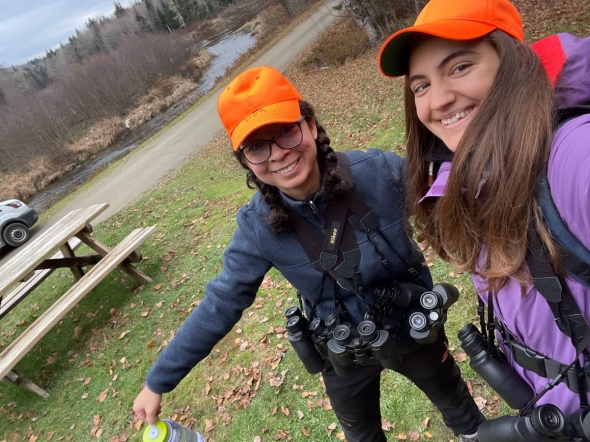

Kalina Duncheva


DOC Trip Leaders and How You Can Become One
DOC stands for Dartmouth Outing Club–a large club with many sub clubs dedicated to the outdoors. The DOC is "the oldest and largest collegiate outing club" in the US (you can read more about it here). The DOC organizes nature-centered trips with a focus on different activities every single day. There are ice-climbing trips, birdwatching trips, canoeing trips, and skiing trips.
But who leads these trips? That's what I am about to tell you.
This week I attended a Flora and Fauna seminar (FnF is a sub club of the DOC that focuses on birding and nature walks) for leaders in training, or saplings to use some FnF jargon. While I'm not planning yet to be a trip leader, many freshmen are already halfway through all of the requirements to lead a trip and will pretty soon be actual DOC leaders.
What exactly is the job of a DOC trip leader?
Trip leaders organize trips, put them up on Trailhead, where other students can sign up for trips, and actually take other students (called trippees) out on adventures. If you are a CnT leader (Cabin and Trail), you'll probably lead a lot of backpacking trips. If you're an FnF leader (Flora and Fauna), you might lead some tree ID trips. If you are a Winter Sports leader, you might lead a backcountry skiing trip to the Dartmouth Skiway. Trip leaders can also get van certified (i.e. you can drive one of the DOC vans, so you can take your trippees somewhere cool - header image shows trip leaders Ian and Levi, Ian is van-certified). They are also responsible for taking care of everyone's dietary needs, so when they're buying food, they have to look on Trailhead everybody's allergies and make sure everyone will have lunch.
When you first come to Dartmouth and join the DOC, you'll meet a lot of trip leaders. If you go to club meetings (as you should!), you'll also hear these leaders announce the trips they're leading out that given week. The first few weeks it's exciting, and you have no idea how these trip leaders manage to organize such adventures. By the end of your first fall or winter term, though, you start peeking behind the curtain and understand that it's not rocket science–and you can, too, become a trip leader.

So how do you become a trip leader?
Well, you need to attend a few seminars on group dynamics and risk management among other topics. You have to get a WFA (wilderness first aid) certificate or even a WFR (wilderness first responder) certification. If you are a Winter Sports leader, you might need to get AIARE certified (avalanche safety). The best thing is that all of these courses are subsidized by the Outdoors Programs Office.
Apart from all of these certifications, you also need to co-lead a few trips, so you learn from current leaders how to set up your trip on Trailhead, how to make sure everyone is safe and happy on your trip, and in general, how to embody the DOC's values in the outdoors.
There will also be other qualifications (like can you light a fire), but these depend on the specific club in which you want to be a leader.
Posts You Might Like

Here is a little peek into how I made my spring break after studying abroad and before Spring term; a relaxing, rejuvenating & explorative experience!


The Upper Valley is full of great places to visit and things to do beyond the Dartmouth campus. Here's one of my favorites!


Greek Life can seem scary to some —including freshman year me. Here are some things I learnt when navigating these spaces!



If you're an admitted student, Dartmouth chose you. Here's why you should choose Dartmouth, in my opinion.


When I first got into Dartmouth, I was confused as to how you get there. Let me break it down!


I have written about being a student worker plenty of times in the past, but I have yet to talk about one of my favorite jobs ever: ticket selling at the Hopkins Center for the Arts.


Congratulations to all the amazing, intelligent, passionate and outstanding members of Dartmouth's Class of 2028.


I had the chance to meet the former president of Kosovo!

